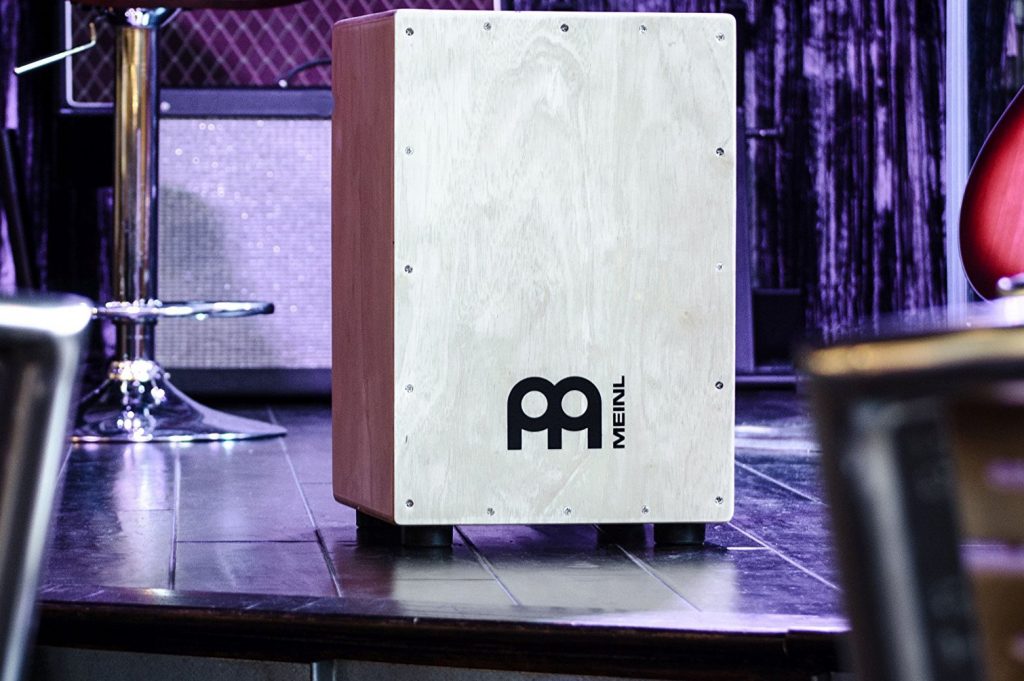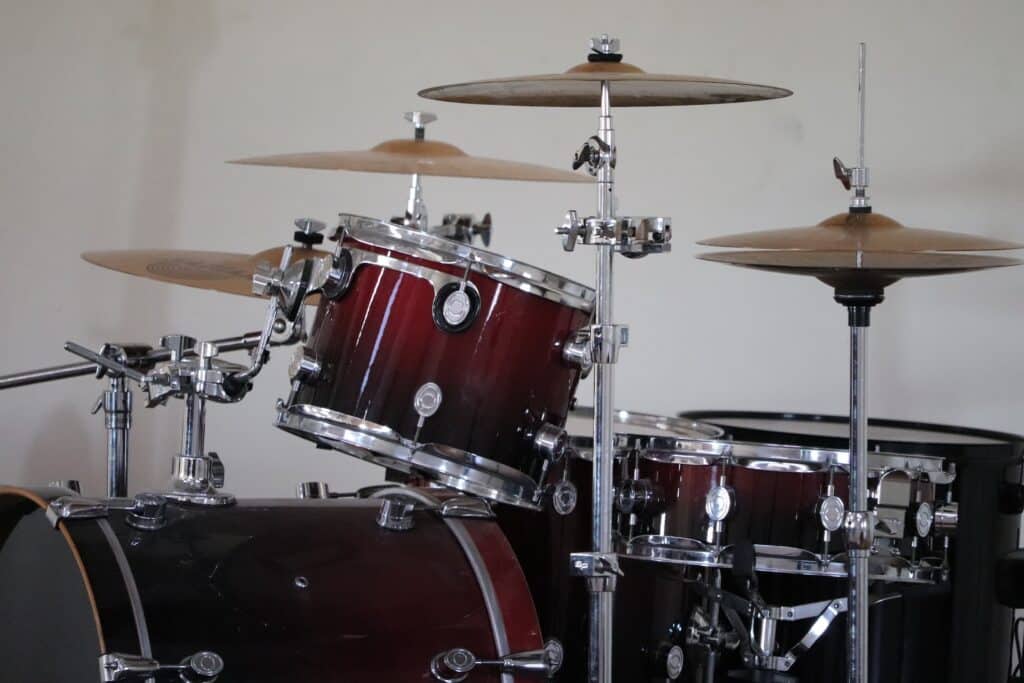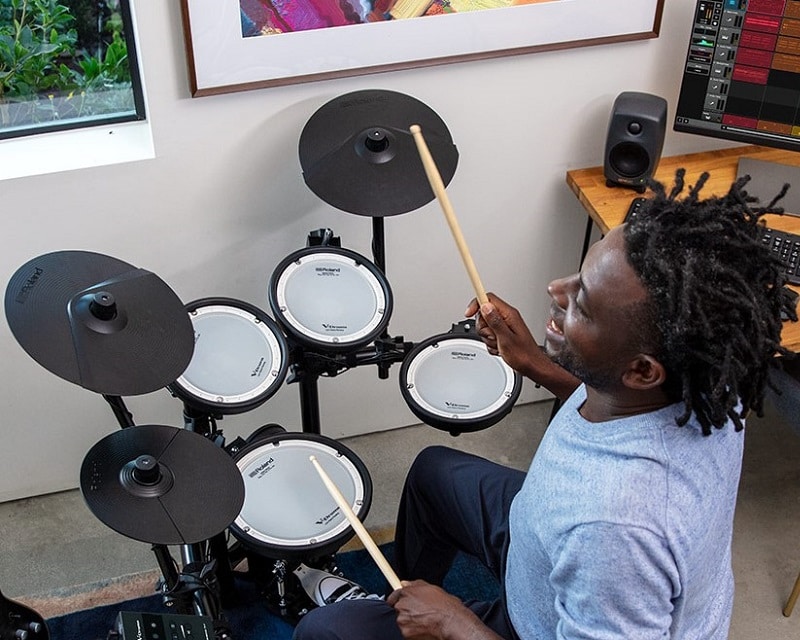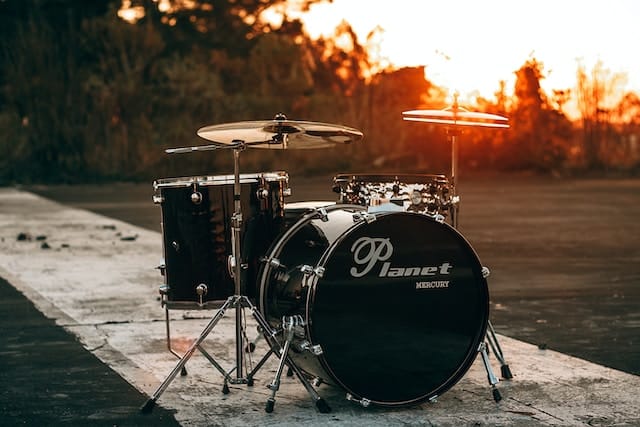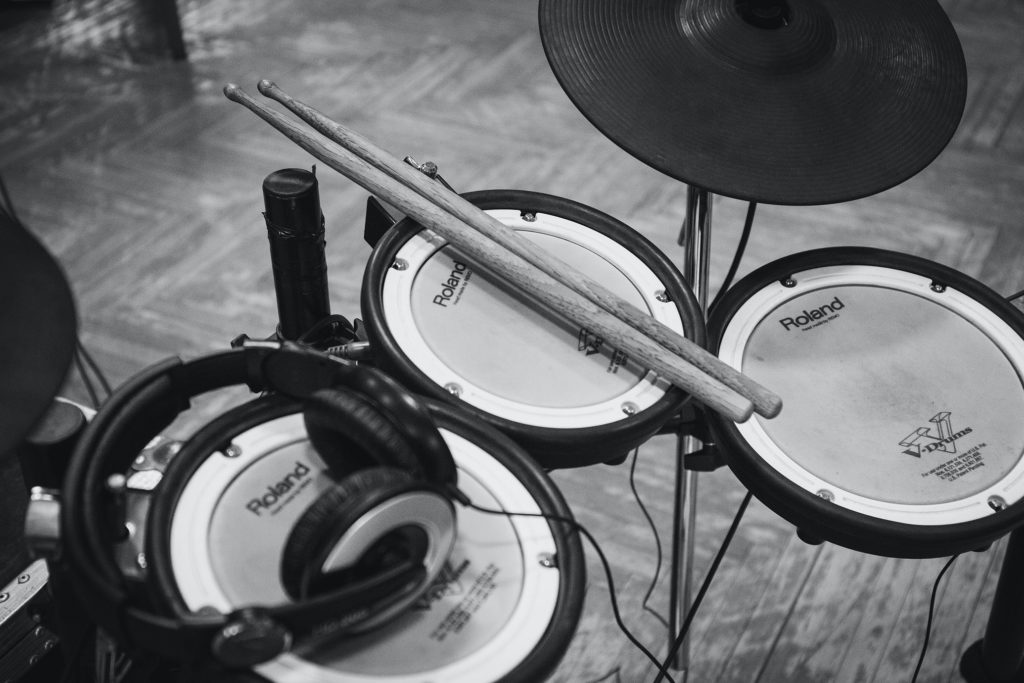Drums are the backbone of all music genres. Pop, country, blues, rock, and roll…it’s nearly impossible to find a song without drums in it.
When you’re dancing, you’re dancing to the drumbeat! It’s what moves the song forward and keeps the band in time. Drummers work long and hard to master their skills.
But when you first start out, it might be confusing how to set up a drum set. There are so many parts, and it’s hard to know what order to work in, where they go, and how they fit together. Drums have a lot of parts, so it can be overwhelming.
The main parts of a drum set are the stool, snare drum, bass drum, bass pedal, hi-hat, tom-toms, and cymbals. Start out with a good beginner drum set and go from there. Soon enough, you’ll be setting up your drum set like a pro!
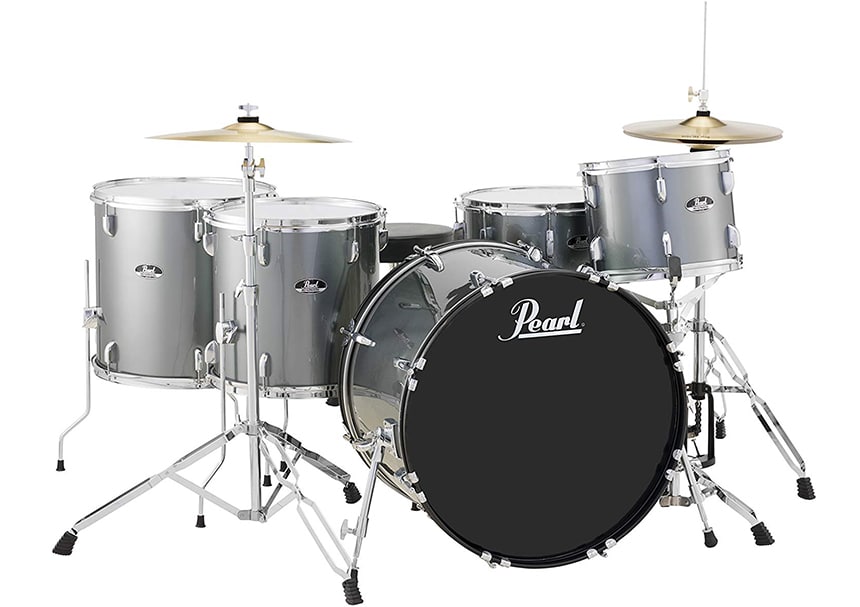
Types of drum sets
There are many ways to set up your drum set, and it all depends on what kind of music you want to play.
The rock/pop drum set is the standard rock drum set. It’s the most popular way to set up your set.
Jazz drum sets place importance on the snare, hi-hat, and ride cymbals. It’s important for a jazz set up to be comfortable because jazz musicians play such intricate beats.
The fusion drum set is used for any combination of jazz or world music, especially Latin music. These setups are large and may include special cymbals or Latin percussion.
Heavy metal drum sets can sometimes use two bass drums! There are also lots of cymbals.
No matter what kind of set up you want, look into the best drum sets to get an idea of what you should be looking for.
Electronic drum sets
Electronic drum sets Trusted Source Electronic drum - Wikipedia Electronic drums is a modern electronic musical instrument, primarily designed to serve as an alternative to an acoustic drum kit. Electronic drums consist of an electronic sound module which produces the synthesized or sampled percussion sounds and a set of ‘pads’, usually constructed in a shape to resemble drums and cymbals, which are equipped with electronic sensors (or triggers) to send an electronic signal to the sound module which outputs a sound to the player. en.wikipedia.org are popular for their infinite possibilities of sound, as well as if you live in a house where you have to practice quietly. Electronic drum sets are also usually cheaper and are great for beginners.
They are smaller than acoustic drum sets and are a lot of fun to play on. You have the ability to change the sound of all of your pieces, so you can experiment to see what you like best and have a lot of fun creating new sounds and patterns.
Electronic drum sets are versatile and can play any musical genre. This is a great example of a versatile electronic drum set.
Since the drum tones are pre-recorded, you can never make a mistake and ruin the sound of a hit. They fold up nicely and are very portable, unlike acoustic drum sets, which are a hassle to transport.
They have ports to plug in earphones so you can play along to songs, learn new beats, and mimic solos you want to learn. They also have built-in metronomes, which keep track of time. It’s also easy to record with them because they can hook up to your computer. You also don’t have to tune an electronic drum set!
Acoustic drum sets
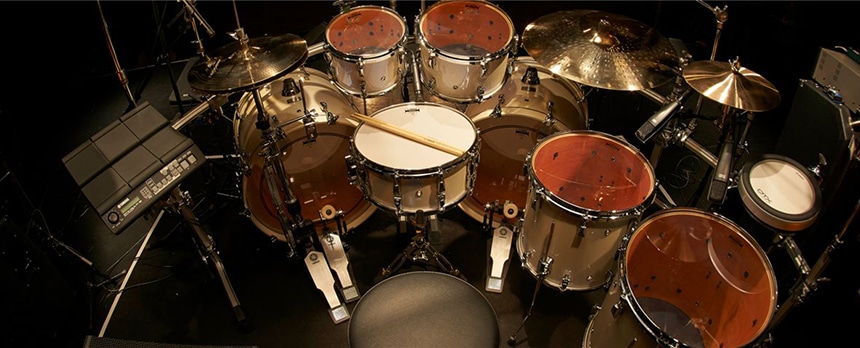
Acoustic drum sets can come in as many forms as you can imagine. Most players take a little bit of each genre’s traditional set up to create their own personalized set to meet their needs.
Most acoustic drum sets consist of at least the following:
- One bass drum
- One snare drum
- One hi-hat cymbal
- One crash cymbal
- One floor tom
- One high tom
When buying a drum set, it’s important to check that the set comes with cymbals and all the necessary hardware. It’s typically cheaper to buy a complete set than it is to buy each piece individually, but as you progress in your playing, you may want to upgrade certain pieces.
Place your drum set on a rug or carpet, so the pieces don’t move or scratch your floor!
It’s possible to make your acoustic drum set quieter by using mutes, which are pieces of rubber that lay on the drum pieces. You can buy bass drum mutes too, but stuffing the drum with pillows or blankets is another way to make the bass drum quieter.
Stool
Drum stools, or drum thrones, are arguably the most important part of your drum set! Setting it up properly will ensure you are comfortable and can effectively reach all the parts of your drum set.
It’s vital to keep the right posture while you’re playing your drum set. The stool height should be high enough that your thighs are a little above your knees. Move your petals, so they’re in a convenient place. As you progress, you can keep your legs parallel to the ground.
- Most children position their stool about 16 inches high.
- Medium-sized drummers keep their stools about 20 inches high.
- Taller players keep their stools as high as 24 inches.
Leg positioning is important too! Here are a few things to keep in mind when positioning your legs while sitting on your stool.
Your legs will create a v-shape. Your stool shouldn’t be too close to the drum set so that you have room to play and you aren’t squished. Your legs should be more than 90 degrees apart, and your ankles should be ahead of your knees.
Snare drum
Snare drums are unique in that they have a row of metal springs attached to the bottom of the drum. The springs are called the “snare.” The snare consists of eight to 18 wires. When a drummer hits a snare drum, they produce vibrations against the bottom of the drum and create a snappy sound. It is usually the smallest drum in the drum set.
The snare drum is usually placed right between the player’s knees on an adjustable stand that can change both the height and angle of the drum.
A good snare drum stand is vital. There are three styles: the basket-style, the classic three-leg style, and the L-style.
You want a stand that has an adjustable basket in case you change the size of your snare drum and one that adjusts in height.
So how do you set up the snare drum? First, set up the stand. The drum’s basket should be parallel to the floor.
Next, remove the snare drum from its case. Slowly put the drum on the stand. The snares have to go on the bottom, and the release level should be facing forward for easy access.
Sit on your stool. The drum should be a little bit below your waist. Angle the drum slightly towards you.
Stand directly in front of the drum. Your forearms should be nearly parallel to the floor when you bend at the elbows.
Bass drums
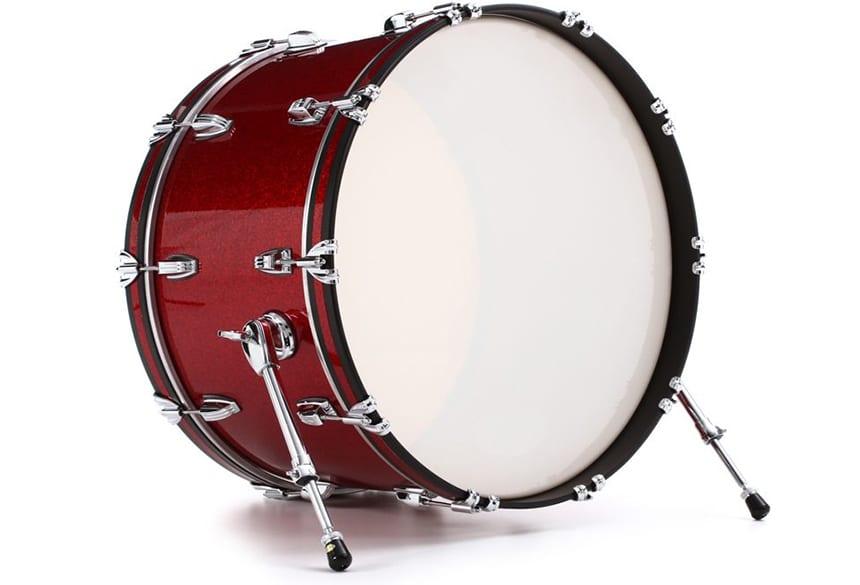
The bass drum is the largest part of your drum set and is also known as a kick drum. It sits vertically on the floor. The player uses a foot pedal to hit the drum, which produces a loud, low sound. The bass drum is the lowest-sounding part of a drum set because it is the biggest. It can be anywhere between 16 to 18 inches in diameter.
The kick drum keeps track of the tempo of a song and is usually hit on beats one and three.
The modern-day kick drum can be traced back to the davul, which is a Turkish drum that is hit with a rod. It also was developed after large concert bass drums used in classical music and the marching bass drum used in marching bands. The bass drum pedal changed all of this and was developed in the early 1900s.
Here are three tips for successfully playing bass drum:
- Try out different bass drums. They all feel different, and it’s important to buy one that you like playing.
- Try a double kick drum pedal. These are common in heavy metal music and let you play the drum two times as fast.
- Play in time with your bass player. This will create a steady beat.
The bass drum is the easiest drum to set up. You attach the two metal legs into the holes on the sides of the drum and then tighten them. Some drums have pre-attached legs that you slide out.
Make sure your legs are extended all the way, and both touch the ground. They should be even in height, so your bass drum isn’t crooked.
The side of the drum with the brand name should be facing away from you.
Bass pedal
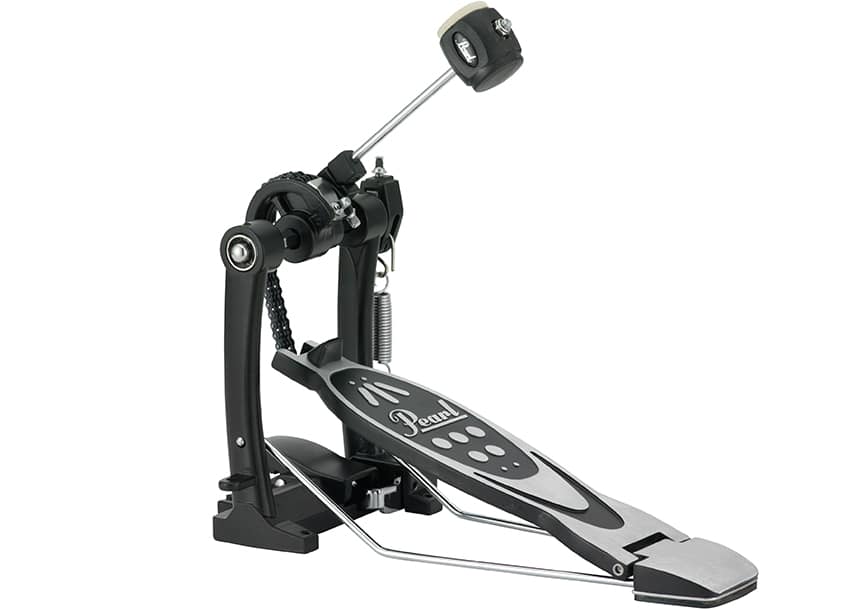
Without a good bass pedal, you won’t be able to play your bass drum to its fullest potential. There are six parts of a pedal.
- The footplate is the base of the drum pedal. The bottoms can be made of either rubber or velcro. It’s important to have a drum rug, so your pedal doesn’t slide.
- Pedal spurs help the pedal dig into the rug, so it doesn’t move.
- The hoop clamp attaches to the bass drum hoop.
- There are two types of footboards: the shortboard and the longboard. The shortboard has a heel plate and a hinge in front. Longboards are flat and have a hinge in the back.
- The drive makes the pedal move and is usually a chain or belt that attaches to the footplate and cam.
- The cam is the piece that catapults the beater forward.
To set up your hoop clamp, loosen the wing bolt and lift your bass drum. Slide in the clamp and tighten the wing bolt.
Along with how you tune your bass drum, beaters determine how your bass drum will sound. Beaters can be made of plastic, which is used for rock or metal, or felt, which produces a warmer sound for music like jazz.
It’s important to use bass drum patches to protect your drum if you’re using a plastic or metal beater.
You can also adjust the tension of the pedal and the angle of the beater, which will fine-tune your pedal.
Hi-hat
The hi-hat is a set of two cymbals that can be played opened or closed. A foot pedal controls the opening and closing of the cymbals. When closed, the hi-hat makes a quick, high-pitched sound. When open, the sound rings out and lasts longer.
Here are the parts of a hi-hat:
- Rod
- Upper tube
- Clutch
- Locknuts
- Non-loose nut
- Angle screw
- Pedal anchor
There are eight main steps to setting up a hi-hat.
- Loosen the T-bolt and fold out the legs.
- Screw-in the rod.
- Put on the washer and then the felt of the bottom cymbal.
- Slide on the bottom cymbal, which will be thicker than the top cymbal.
- Attach the top cymbal to the clutch.
- Slide the clutch onto the rod.
- Adjust the height of the upper cymbal.
- Move the stand where you want it.
There are also some important tips to make sure your hi-hat is functioning properly.
Adjust the legs. Make sure the pedal anchor isn’t on the ground or supporting too much weight. If it’s touching the ground, the stand will move around. But you don’t want the pedal anchor too high off the floor either.
Adjust the spurs so that the stand digs into your rug. Don’t use them on a wooden floor. Be gentle with your rod/stand to protect it from being bent. Here is a list of the best hi-hat stands so you will have the sturdiest stand possible. This stand is another great option.
Any cymbals can be used on a hi-hat, not just hi-hat cymbals. Experiment to find the sound you like. Play around with how high the top cymbal is.
Tom Toms
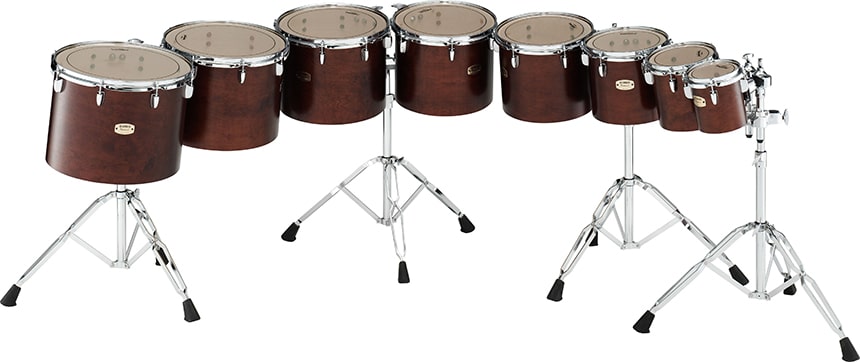
Tom toms were first brought to the United States by Chinese immigrants in the late 1800s. Chinese toms were painted colorfully and were adapted to use for sound effects in stage shows, silent films, and radio. They were glued in place and therefore could not be tuned.
Tom toms were slowly innovated so that by the time the big swing bands of the 1930s rolled out. Toms was the perfect volume and pitch. They were a perfect addition to drum solos as well.
The toms are placed right in front of the drummer. They come in a large variety of sizes, each size being higher or lower in pitch. Most drum sets have two toms attached on top of the bass drum.
The floor tom is just like the other toms, except larger. It stands on the floor and has a deeper sound. It is located opposite the snare.
There are two major ways to set up your tom-toms. The first way is to attach it to a cymbal stand or the bass drum. If you use an L-rod and a RIMS mount, the tom will ring out more. If you attach the tom to a cymbal stand, you will have more options to adjust your tom. Make sure the tom isn’t too heavy for the stand!
The other way to set up a tom is to put it in a snare basket. This will place the tom lower than the other method.
Cymbals
There are two main types of cymbals: crash cymbals and ride cymbals. Most drum sets have two crash cymbals and one ride cymbal. The crash cymbals are used for accenting important moments in a song, while the ride cymbal is used more throughout the song as a steady beat.
The crash cymbals are located above the tom-toms, and the ride cymbal is located above the floor tom.
Because the ride is used so often, you don’t want to have to bend your wrist or move your body to reach it. If you imagine 12 o’clock being straight ahead, you want your ride to be at 1 or 2 o’clock.
The ride should be low enough that the stick falls on it naturally. It should be angled so that you have access to all parts of the cymbal. Each part creates a different sound. However, you don’t want it overly angled either.
Your crash cymbals should be near your tom-toms. They shouldn’t interfere with playing your toms but need to be right in that area. They should be slightly angled and at a low enough height that you aren’t reaching.
You can also add splash or china cymbals, which add unique sounds. You won’t be playing these cymbals as frequently as your crash or ride cymbals, so they don’t have to be so close in reach. They can simply be placed to the left or right of your drum set, as long as you can still reach them.
Final thoughts
It’s important to know how to set up a drum set so that your playing is as easy as possible. The better your drum set is set up, the more you can progress in skill and the faster your progress will be. Try out a lot of different gear at the store and see what you like best. As you get better, you can upgrade individual parts of your drum set to create the perfect set up for you. Get to know each part of your drum set well. It will help you become a better player. Now that you know how to set up a drum set, it’s time to get playing!










